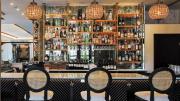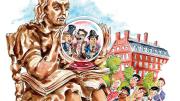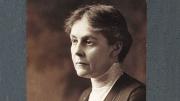For the installation of its twenty-seventh president, Harvard displayed on a stage set up at the front of Tercentenary Theatre various sacred relics: the keys to the College, silver, the largest nine inches long; the charter of 1650, which established what is now the oldest corporation in the Western Hemisphere; a compilation of official College records from 1639 to 1795; College seals; and eight pieces of historic silverware from Fogg Art Museum vaults, among them the four shown here.
The Dunster Tankard (far right) was once said to have belonged to Harvard's first president, Henry Dunster, a chronological impossibility as it was made by Ephraim Cobb in Massachusetts circa 1740 and Dunster met his maker in 1659. The initials "H.D." are engraved on the handle, and it may have belonged to others with his name.
The Stoughton Cup (second from left) was crafted by John Coney (1656-1722), one of Boston's best silversmiths. Skilled with his gravure, he fashioned a seal for the College and plates for the first paper money issued by the colony. He made this ceremonial grace cup, meant to be passed around at the end of a meal for the final toast, 10 inches high, in the baroque William and Mary style, with fluting and gadrooning, for Lieutenant Governor William Stoughton, A.B. 1650, whose arms it bears. Stoughton was chief justice of the court that heard the Salem witchcraft trials, and perhaps to atone for that he was Harvard's most generous seventeenth-century patron. He intended to hand the cup to the College president at Commencement in 1701. Samuel Sewall delivered it on his behalf, for Stoughton was ailing, and a week later he died.
The Holyoke Cup (second from right), also by Coney, was a domestic utensil called a caudle cup after the warm drink of ale or wine mixed with sugar, spices, eggs, or bread and generally served to the peaked, but it came to be used on ceremonial occasions such as baptisms. It once belonged to President Edward Holyoke.
The Great Salt, Harvard's oldest piece of silver, was made in London, probably before the College was founded, and came to America with Elizabeth Glover, who married Henry Dunster. When salt was costly and prized, one container of it sat at the head of the table before the most important person dining. Auspiciously, on this inaugural occasion, the Great Salt was displayed right-side-up before Lawrence H. Summers, for Harvardians have gotten through the long period in their history when they were confused about the salt and had it stand on what appear to be three scroll legs, but which in reality are meant to support a plate of fruit to be eaten at the end of a meal.





